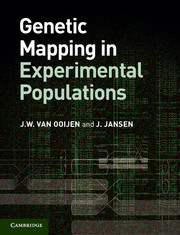Book contents
- Frontmatter
- Contents
- Preface
- 1 Introduction
- 2 Meiosis and genetic recombination
- 3 Estimation of recombination frequencies
- 4 Determination of linkage groups
- 5 Estimation of a genetic map
- 6 Criteria for the evaluation of maps
- 7 How to find the best map order
- 8 Outbreeding species
- 9 Mapping in practice
- Answers to exercises
- Index
- References
2 - Meiosis and genetic recombination
Published online by Cambridge University Press: 05 August 2013
- Frontmatter
- Contents
- Preface
- 1 Introduction
- 2 Meiosis and genetic recombination
- 3 Estimation of recombination frequencies
- 4 Determination of linkage groups
- 5 Estimation of a genetic map
- 6 Criteria for the evaluation of maps
- 7 How to find the best map order
- 8 Outbreeding species
- 9 Mapping in practice
- Answers to exercises
- Index
- References
Summary
A genetic linkage map is a representation of the relative positions of genetic loci on the chromosomes. Its construction is based on knowledge of how often alleles of different loci are inherited together or become exchanged by genetic recombination. Therefore, it is important to understand how genetic recombination takes place during meiosis. In eukaryotic organisms, meiosis is a series of two special cell divisions, enabling the creation of new combinations of alleles. The alternative type of cell division, called mitosis, merely produces genetically identical copies of cells. This chapter contains a concise description of meiosis as far as is relevant for the understanding of genetic recombination. Recombination frequency is introduced as a measure of the rate of genetic recombination.
The life cycle and the ploidy level
A cell containing one basic set of chromosomes is called haploid. A cell containing two sets is called diploid. In some species, cells contain more than two sets of chromosomes; such species are called polyploid and will be discussed briefly in Section 2.7. The life cycle of eukaryotic species is characterized by successions of haploid and diploid phases. In both phases, mitosis enables vegetative growth leading to multicellular organisms or it enables multiplication leading to more, genetically identical individuals, as in microorganisms. Meiosis is responsible for the transition from the diploid to the haploid phase. At some stage, two haploid cells will merge to form the so-called zygote, thereby closing the life cycle at the diploid level. The lengths of the haploid and diploid phases of the life cycle vary greatly among and within higher and lower eukaryotes. For example, for most fungi, the zygote forms the entire diploid phase in the life cycle: the zygote goes directly into meiosis and the resulting haploid cells divide mitotically into multicellular haploid mycelia. In most animals, the four cells produced by meiosis develop into gametes without further cell divisions, and the gametes are ready to fuse with gametes of the opposite sex to form diploid zygotes. Here, the gametes represent the entire, but very short, haploid phase in the life cycle. In most higher plants, the four meiotic daughter cells undergo a few mitotic divisions before the gamete is produced. The life cycle can also be more complicated: for instance, in honey bees the drones (the males) are haploid, the worker bees (the females) are diploid but sterile, and the queen bee is diploid and fertile.
- Type
- Chapter
- Information
- Genetic Mapping in Experimental Populations , pp. 9 - 20Publisher: Cambridge University PressPrint publication year: 2013



